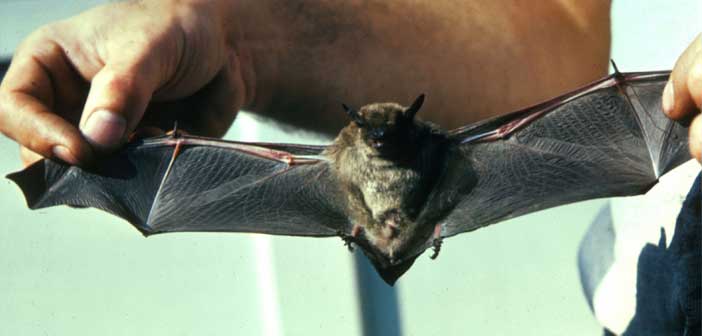Ontario’s little brown bat population now endangered species
PETERBOROUGH—They have been the nocturnal nemesis of those flying pests that bedevil farmers and picnickers for millennia, but an invasive fungal spore may well prove the death knell for the little brown bat. Once ranked as the most common bat in Ontario, listings for the bat now ominously contain the caveat “formerly the most common” and the minute mosquito munching flyers have recently taken up residence on the endangered species list.
Chris Heydon, policy adviser for wildlife health for the Ministry of Natural Resources and Forestry, is the acknowledge bat expert in the Ontario government and spoke to The Expositor from his office in Peterborough. He confirmed the precarious status of the little brown bat. “That description is very likely accurate,” he said, explaining that although the bat may not be the only one of its genus to be impacted by the invasive white fungus, the spores have had an inordinate impact on the smallest of Ontario’s bat species.
“They are among the most effected because they are very small and its comfort margin is not very wide,” he said. “When you add a stressor it can have a huge impact. That impact may even lead to the extirpation of the species.”
The destruction of the little brown bat is linked to white-nose syndrome (WNS), an emerging disease associated with the deaths of millions North American bats. The condition, named for a distinctive fungal growth around the muzzles and on the wings of hibernating bats, was first spotted in a photograph taken in a cave in Schoharie County, New York, sometime in February 2006. Since then the fungus has rapidly spread and as of September 2014, the fungus has been found in caves and mines throughout the northeastern United States and Canada, having been identified as far south as Mississippi, west to Missouri and in at least five Canadian provinces.
The disease is caused by pseudogymnoascus destructans, the spores formerly known as geomyces destructans, which is believed to have arrived in North America from its stomping grounds in Europe into this continent’s caves by hitchhiking on the boots and other equipment of caving enthusiasts that were not thoroughly cleaned. The impact has been precipitous with the decline of species impacted by the fungus topping 90 percent.
It is not directly the fungus itself that is causing the decline in the little brown bats, however, it is the bat’s reaction to the clinging white mess.
Mr. Heydon explained that the little brown bats gather in warm moist caves and other dark places during the winter where their metabolisms slow to a crawl to allow them to wait out the insect-less winter months. “The fungus grows around the bat’s muzzles and interferes with their breathing,” he said. “They rouse from their torpor to groom and drink.” Because their body mass is so slight, the little brown bat’s fat reserves prove to not be up to the challenge of the mid winter activity.
“They also seem to think that maybe there might be some insects around when they wake up and fly out of their shelter in the middle of February,” said Mr. Heydon. “They don’t find any and with their small bodies, they don’t make it back.” The snowbanks outside the entrances to the hibernation shelters become littered with tiny brown bodies.
The loss of the little brown bat will be “a huge threat to the biodiversity” of the North American ecology, said Mr. Heydon.
The way the fungus impacts the little brown bat is an odd anomaly, as there are many other fungi that inhabit the caves that are very similar to the whitenose causing version. “Swabs in caves have identified 18 different fungi that are structurally similar,” he said. “But it is only pseudogymnoascus destructans that is causing the symptoms.”
The impact of whitenose on the little brown bat has focussed scientific investigation on bat species, adding significantly to a body of scientific knowledge that had been remarkably sparse prior to the advent of the disease. Mr. Heydon surmised that the nocturnal nature of bats and the relative inaccessibility of their habitat probably played a part in the sparseness of the record.
Due to the disease, the US Fish and Wildlife Service (USFWS) has called for a moratorium on caving activities in the affected areas and strongly recommends that any clothing or equipment used in such areas be decontaminated after each use. Mr. Heydon said that it would be appreciated if Canadian spelunkers followed suit. “These are naturally dangerous places,” he noted. “Not the kind of places you would want to be wandering around.”
Disinfecting caving equipment is problematic, however, noted Mr. Heydon, in part because adopting the formulations that have been identified as effective in studies in the US do not necessarily translate to the product brands sold in Canada. “The chemical compositions are often different,” he said.
Although the decline in the numbers of the little brown bat has been precipitous and the challenges in dealing with the fungus huge, the provincial government has not been complacent in dealing with the challenge, efforts to combat the disease are ongoing. Some of the proposals include placing aerosols in identified hibernaculum and creating ready-built bunkers where the bats can find a safe haven from the disease. But while that may prove effective in preventing extinction, the scale of the die-off is daunting.
“We used to get reports of five million or six million dead bats,” said Mr. Heydon. Now, the numbers that have been lost are so huge the count has exceeded recording capacity. Still, Mr. Heydon would appreciate reports of finding dead or day-flying bats. “If people could record the location and time of day and report that to us at the ministry that would be very helpful,” he said.
If you find bats roosting in your building, the public is advised to realize that the little brown bat is considered endangered and therefore protected. “Call us before you take any action,” he said.
Hopefully, a solution will be found to turn around the decline in the bat’s numbers. Did we mention the little brown bat can eat as much as its own weight in mosquitoes and black flies in a single night?





